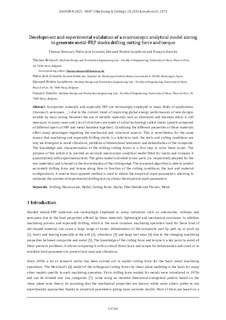| dc.rights.license | Attribution 4.0 International | * |
| dc.contributor.author | ARRAZOLA, PEDRO JOSE | |
| dc.contributor.other | Beuscart, Thomas | |
| dc.contributor.other | Rivière-Lorphèvre, E. | |
| dc.contributor.other | Ducobu, François | |
| dc.date.accessioned | 2022-05-09T14:03:51Z | |
| dc.date.available | 2022-05-09T14:03:51Z | |
| dc.date.issued | 2021 | |
| dc.identifier.isbn | 978-287019302-0 | en |
| dc.identifier.other | https://katalogoa.mondragon.edu/janium-bin/janium_login_opac.pl?find&ficha_no=166683 | en |
| dc.identifier.uri | https://hdl.handle.net/20.500.11984/5568 | |
| dc.description.abstract | Composites materials and especially FRP are increasingly employed in many fields of applications (transport, aerospace, …) due to the current trend of improving global energy performances of new designs notably by mass saving. However the use of metallic materials such as aluminum and titanium alloys is still necessary in many cases and a lot of structures are made of a dual technology called stacks (panels composed of different layers of FRP and metal bounded together). Combining the different properties of these materials offers many advantages regarding the mechanical and structural aspects. This is nevertheless for the same reason that machining and especially drilling stacks is a laborious task: the tools and cutting conditions are way too divergent to avoid vibrations, problems of dimensional tolerances and delamination of the composite. The knowledge and characterization of the drilling cutting forces is a first step to solve these issues. The purpose of this article is to provide an accurate macroscopic analytical model fitted for stacks and compare it quantitatively with experimental tests. The given model is divided in two parts (i.e. respectively adapted for the two materials) and is based on the discretization of the cutting edge. The proposed algorithm is able to predict accurately drilling force and torque along time in function of the cutting conditions, the tool and material configurations. A reverse least squared method is used to obtain the empirical input parameters, allowing to minimize the number of experimental drilling tests to obtain the empirical input parameters. | es |
| dc.language.iso | eng | en |
| dc.rights | © 2021 The authors | en |
| dc.rights.uri | http://creativecommons.org/licenses/by/4.0/ | * |
| dc.subject | Drilling | en |
| dc.subject | Macroscopic | en |
| dc.subject | Model | en |
| dc.subject | Cutting forces | en |
| dc.subject | Stacks | en |
| dc.subject | Fiber Reinforced Plastics | en |
| dc.subject | Metal | en |
| dc.title | Development and experimental validation of a macroscopic analytical model aiming to generate metal-FRP stacks drilling cutting force and torque | en |
| dcterms.accessRights | http://purl.org/coar/access_right/c_abf2 | en |
| dcterms.source | ESAFORM Proceedings | en |
| local.contributor.group | Mecanizado de alto rendimiento | es |
| local.description.peerreviewed | true | en |
| local.identifier.doi | https://doi.org/10.25518/esaform21.2373 | |
| local.contributor.otherinstitution | https://ror.org/02qnnz951 | es |
| local.source.details | N. artículo, 2373, 2021 | en |
| oaire.format.mimetype | application/pdf | |
| oaire.file | $DSPACE\assetstore | |
| oaire.resourceType | http://purl.org/coar/resource_type/c_c94f | en |
| oaire.version | http://purl.org/coar/version/c_970fb48d4fbd8a85 | en |








